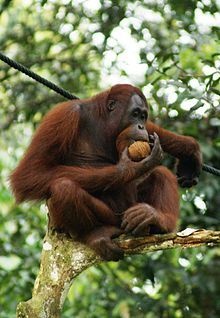
Apes (Hominoidea) are a branch of Old World tailless anthropoid catarrhine primates native to Africa and Southeast Asia. They are distinguished from other primates by a wider degree of freedom of motion at the shoulder joint as evolved by the influence of brachiation. There are two extant branches of the superfamily Hominoidea: the gibbons, or lesser apes; and thehominids, or great apes.
- The family Hylobatidae, the lesser apes, include four genera and a total of sixteen species of gibbon, including the lar gibbon and the siamang, all native to Asia. They are highly arboreal and bipedal on the ground. They have lighter bodies and smaller social groups than great apes.
- The family Hominidae, known collectively as the great apes, include orangutans, gorillas, chimpanzees, and humans;[1][2][3][4] alternatively, this family clade is also known as thehominids. There are seven extant species of great apes: two in the orangutans (genus Pongo), two in the gorillas (genus Gorilla), two in the chimpanzees (genus Pan), and a single extant species, Homo sapiens, of modern humans (genus Homo).[5][6]
Members of the superfamily Hominoidae are called hominoids—which term is not to be confused with hominids, the family of great apes; or with the hominins, the tribe of humans also known as the human clade; or with other very similar terms of primate taxa. (Compare terminology of primate names.)
Recent evidence has changed our understanding of the relationships between the hominoids, especially regarding the human lineage; and the traditionally used terms have become somewhat confused. Competing approaches re methodology and terminology are found among current scientific sources. See below, History of hominoid taxonomy and see Primate: Historical and modern terminology for discussions of the changes in scientific classification and terminology regarding hominoids.
Some and, recently, all, hominoids are also called "apes", but the term is used broadly and has several different senses within both popular and scientific settings. "Ape" has been used as a synonym for "monkey" or for naming any primate with a humanlike appearance, particularly those without a tail.[7] Thus the Barbary macaque, a kind of monkey, is popularly called the "Barbary ape". Biologists have traditionally used the term "ape" to mean a member of the superfamily Hominoidea other than humans,[1] but more recently to mean all members of Hominoidea. So "ape"—not to be confused with "great ape"—now becomes another word for hominoid including humans.[4][8]
Except for gorillas and humans, hominoids are agile climbers of trees. Their diet is best described as frugivorous and folivorous, consisting mainly of fruit, nuts, seeds, including grass seeds, leaves, and in some cases other animals, either hunted or scavenged, or (solely in the case of the humans) farmed—along with anything else available and easily digested.[9][10]
Most non-human hominoids are rare or endangered. The chief threat to most of the endangered species is loss of tropical rainforest habitat, though some populations are further imperiled by hunting for bushmeat. The great apes of Africa are also facing threat from the Ebola virus. Currently considered to be the greatest threat to survival of African apes, Ebola is responsible for the death of at least one third of the species since 1990.[11]
Historical and modern terminology[edit]
"Ape", from Old English apa, is a word of uncertain origin.[12] The term has a history of rather imprecise usage—and of comedic or punning usage in the vernacular. Its earliest meaning was generally of any non-human anthropoid primate,[7][13] as is still the case for its cognates in other Germanic languages.[14] Later, after the term "monkey" had been introduced into English, "ape" was specialized to refer to a tailless (therefore exceptionally human-like) primate.[15] Two tailless species of macaque still have common names using "ape": the Barbary ape of North Africa (introduced intoGibraltar), Macaca sylvanus, and the Sulawesi black ape or Celebes crested macaque, M. nigra. Thus, the term "ape" obtained two different meanings, as shown in the 1910 Encyclopædia Britannica entry: it could be used as a synonym for "monkey" and it could denote the tailless humanlike primate in particular.[7]
The primates called "apes" today became known to Europeans after the 18th century. As zoological knowledge developed, it became clear that taillessness occurred in a number of different and otherwise distantly relatedspecies. Sir Wilfrid Le Gros Clark was one of those primatologists who developed the idea that there were trends in primate evolution and that the extant members of the order could be arranged in an ".. ascending series", leading from "monkeys" to "apes" to humans. Within this tradition "ape" came to refer to all members of the superfamily Hominoidea except humans.[1] As such, this use of "apes" represented a paraphyletic grouping, meaning that even though all species of apes were descended from a common ancestor this grouping did not include all the descendant species, because humans were excluded from being among the apes.[16]



